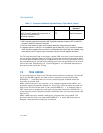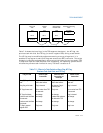
7-18 Vol. 3
TASK MANAGEMENT
7.4.1 Use of Busy Flag To Prevent Recursive Task Switching
A TSS allows only one context to be saved for a task; therefore, once a task is called
(dispatched), a recursive (or re-entrant) call to the task would cause the current
state of the task to be lost. The busy flag in the TSS segment descriptor is provided
to prevent re-entrant task switching and a subsequent loss of task state information.
The processor manages the busy flag as follows:
1. When dispatching a task, the processor sets the busy flag of the new task.
2. If during a task switch, the current task is placed in a nested chain (the task
switch is being generated by a CALL instruction, an interrupt, or an exception),
the busy flag for the current task remains set.
3. When switching to the new task (initiated by a CALL instruction, interrupt, or
exception), the processor generates a general-protection exception (#GP) if the
busy flag of the new task is already set. If the task switch is initiated with an IRET
instruction, the exception is not raised because the processor expects the busy
flag to be set.
4. When a task is terminated by a jump to a new task (initiated with a JMP
instruction in the task code) or by an IRET instruction in the task code, the
processor clears the busy flag, returning the task to the “not busy” state.
The processor prevents recursive task switching by preventing a task from switching
to itself or to any task in a nested chain of tasks. The chain of nested suspended tasks
may grow to any length, due to multiple calls, interrupts, or exceptions. The busy
flag prevents a task from being invoked if it is in this chain.
The busy flag may be used in multiprocessor configurations, because the processor
follows a LOCK protocol (on the bus or in the cache) when it sets or clears the busy
flag. This lock keeps two processors from invoking the same task at the same time.
See
Section 8.1.2.1, “Automatic Locking,” for more information about setting the
busy flag in a multiprocessor applications.
7.4.2 Modifying Task Linkages
In a uniprocessor system, in situations where it is necessary to remove a task from a
chain of linked tasks, use the following procedure to remove the task:
1. Disable interrupts.
2. Change the previous task link field in the TSS of the pre-empting task (the task
that suspended the task to be removed). It is assumed that the pre-empting task
is the next task (newer task) in the chain from the task to be removed. Change
the previous task link field to point to the TSS of the next oldest task in the chain
or to an even older task in the chain.
3. Clear the busy (B) flag in the TSS segment descriptor for the task being removed
from the chain. If more than one task is being removed from the chain, the busy
flag for each task being remove must be cleared.
4. Enable interrupts.


















